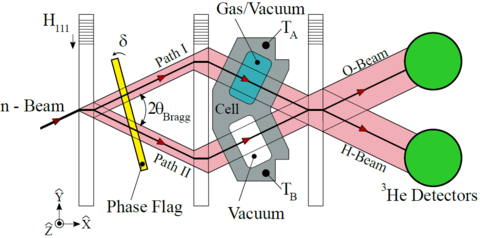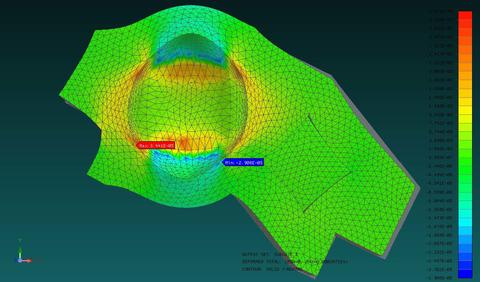Interferometry: Precision Scattering Length Measurements of Low-Z Isotopes using Neutron Interferometry
Summary
The Neutron Interferometer and Optics Facility continues to provide high precision measurements of scattering lengths for the purpose of improving few-body nuclear theory and effective field theory calculations.
Description

Figure 1. Overhead view of the experimental setup.
The neutron-nucleus interaction potential can be described by a constant with the dimension of length called the neutron scattering length. In general, the scattering length (b) is spin-dependent, a complex number, and most importantly isotope-dependent. Neutron scattering lengths are fundamental in neutron scattering applications and are widely used in neutron science and nuclear engineering. They provide a benchmark for few-body nucleon potential models and chiral effective field theories. A significant motivation for more precise neutron scattering length measurements is to provide high-quality “set-point” data for effective range expansions of neutron + nucleus systems. These expansions can be used to assist construction of improved realistic 3-Nucleon and 4-Nucleon potential models and constrain low energy constants in chiral effective field theory. It is hoped that such new models will bring few nucleon theory and experiment into better agreement. In addition, precise neutron scattering lengths of noble gases are needed for short-range interaction searches using cold and ultracold neutrons.
Since 2001, the neutron interferometry group at NIST has been providing the highest precision measurements of gas scattering lengths. This includes the spin-independent scattering lengths of hydrogen, deuterium, helium-3, as well as the spin-dependent scattering length of helium-3. Our latest work has been on measuring the spin-independent scattering length of helium-4, a challengingly weak interaction.
The setup for these measurements is shown in Figure 1. A neutron interferometer is used to create two spatially separated but entangled neutron paths. A double chambered cell made from aluminum is placed inside the interferometer. One chamber of the cell is filled with target helium gas while the other cell is evacuated. The phase shift acquired by the neutron as it passes through the helium is measured as a changed in intensity at the two neutron detectors. This phase shift is proportional to the scattering length of helium. To measure systematics this experiment was performed at several different target pressures ranging from 7 bar to 13 bar.
Because the neutron-helium is such a weak interaction, several systematic effects were found during this iteration of the program. Among these was a systematic phase offset that we denoted as the shadow phase. This shadow phase was mostly eliminated from the result using a complex measurement pattern. Our largest systematic and correction was due to the Al cell walls deforming under the pressure of the helium gas. This correction was calculated using finite element analysis (FEA), shown in Figure 2.

Our final result for the n-4He scattering length is
b = [3.0982 ± 0.0021 (stat.) ± 0.0014 (syst.)] fm
This value is a 2% downward shift in the previous accepted value and a reduction in the net uncertainty by a factor of more than six. The Neutron Interferometer and Optics Facility will continue these measurements on other gas samples. Concerning our most recent work, the spin-dependent scattering length of helium-3 result was published in Huber et al., Phys. Rev. C 90, 064004(2016) and details of our latest work for helium-4 can be found in Haun et al., Phys. Rev. Lett. 124, 012501(2020).

